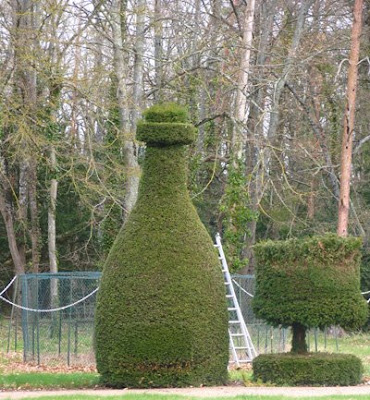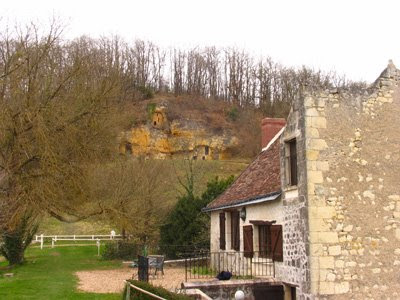26th March 2009
Some of my wine writing friends claim that the Loire is complicated – so many appellations! Actually there are around 70 about the same number as in the Côte d’Or, although there you only have two main grape varieties. If you start the Loire appellations the region may seem complicated. However, the key to understanding the Loire is through the change in climate from west to east and how that affects what varieties you can successfully plant. So climate and grape varieties are the key to the Loire. But that will have to be the subject of a future posting, as I must get back to my visit with Christophe Baudry to Baudry-Dutour’s recent acquisitions.
First a little history. The Baudry family has owned the Domaine de la Perrière in Cravant-les-Coteaux since 1398. Christophe is latest generation of the Baudrys to run the estate. His father Jean, the elder brother of Bernard Baudry, has now retired and with his wife looks after their chambres d’hôtes business. In 2003 Christophe Baudry joined with Domaine de la Roncée in Panzoult run by Jean-Martin Dutour. – hence Baudry-Dutour. The industrialist Bernard Tardi bought Domaine de la Roncée in 1992 from the Donnabella family. Tardi had made his fortune with a petrol distribution business, which he sold in 1979.
Not being in the wine producing business Tardi looked around for someone to run Domaine de la Roncée. Initially he chose Paul Filliatreau (Saumur-Champigny) to oversee operations. However this was not a success and the arrangement only lasted a few months. For a brief period after that one of the Donnabellas helped out until in September 1993 Tardi hired the young Jean-Martin Dutour, who had only recently completed his studies into agronomy and oenology at Montpellier. Jean-Martin is originally from around Bar-le-Duc. Appointing the young and then inexperienced Jean-Martin must have been a considerable gamble on Tardi’s part. However it is clearly a gamble that has paid off.
Although Christophe is a good winemaker he is stronger at the commercial side than Jean-Martin, whose strength is in winemaking rather than the commercial aspects. Thus it made sense to combine forces. Since then Baudry-Dutour has made several new acquisitions: the vineyard of Château Saint-Louans, the Clos des Capucins and most recently Château de la Grille. This brings them up to 120 hectares.
Our first visit was to Château de la Grille, which is just to the north of Chinon. On the way from Panzoult to la Grille, Christophe explained that since last year’s elections he was now Maire of Cravant-les-Coteaux. Apparently the Maire of Cravant is always a vigneron and it was Christophe’s turn. Initially he was reluctant but a delegation persuaded him to stand, so I was spending the morning with un grand fromage (big cheese)!
 Topiary in the grounds of Château de la Grille – may explain why La Grille has always had a rather poncy bottle
Topiary in the grounds of Château de la Grille – may explain why La Grille has always had a rather poncy bottleI have never been impressed with Château de la Grille’s Chinon finding lacking fruit and with dry tannins in the finish, so this was my first visit to the property. There are 26 hectares of vines. 13 hectares around the château on quite flat ground (argile-calcaire) and another 13 hectares nearby on a small dome by the main road that skirts `Chinon. The estate is entirely planted with Cabernet Franc. I fancy that the domed part is the better terroir.
Several reasons for La Grille’s poor showing soon became apparent. Only one cuvée is made and some of the barriques used to age the wine are 10-12 years old. Christophe explained that the old barrels will go and that in future La Grill will be aged in barriques of 1-3 wines. Only the better wine will go into La Grille. That considered not to be good enough will be sold under another label or sold to the négoce. The vineyard will be grassed over with the height of the vines raised to produce more leaves and so more photosynthesis.
La Grille’s wines are made by Jean-Max Manceau, who has worked here for 28 years and who also has his own Chinon domaine – Domaine de Noire. He is also president of the Chinon producers' syndicat. Jean-Max will continue to look after the winemaking here.
 Obama often seeks the Maire's advice!
Obama often seeks the Maire's advice!Then Christophe and I headed off to the vineyard of Château Saint-Louans. Saint-Louans is now a suburb of Chinon – just to the west of the town, overlooking the Vienne. Christophe described this 6-hectare plot as Chinon’s best terroir. Jean-Martin Dutour later qualified this – saying that in average to difficult years this was the best. However in very good to great years, there are other sites in Chinon that perform better. It is clay and limestone here and Cabernet Franc vines are between 25 and 35 years old. 2007 was the first vintage here for Baudry-Dutour. Apparently there was considerable competition to buy this vineyard with other candidates including Bernard Baudry and Domaine Charles Joguet.
Just overlooking the Vienne is a small parcel – Haut-Bois is the lieu-dit, although it is not used on the label – of Chenin Blanc, which is also part of Château Saint-Louans. I checked with Christophe how many hectares of Chenin are now planted in the appellation. “There are 36/37 hectares planted and a stop has been put on further planting. Chenin on works on the coteaux (argile-calcaire) and people were wanting to be able to plant it on the gravels of the valley, which would not have been suitable.”
From there Christophe and I moved onto the Clos des Capucins – a little west of the Château de Chinon and overlooking the Clos des Hospices, which was replanted last year by Rodolphe Raffault. The three hectare Clos des Capucins, which has a magnificent position close to the Vienne and the Château, has 1.70 ha of vines that are now being renewed by Baudry-Dutour. Christophe told me that the vineyard used to looked after by Jean-Maurice Raffault, a well known producer of Chinon in Savigny-en-Véron. However, when the previous owner came to sell Raffault did not want to buy the Clos. Instead Rodolphe Raffault is now looking after the recently replanted Clos de l’Hospice, which is adjacent to and overlooked by the Clos des Capucins.
The work on the vines of the Clos des Capucins is almost entirely done by hand and the Clos vineyard will be farmed organically. “We will also be renovating the house and offering chambres d’hôtes as well as a place to taste and eat – like a wine bar – and be able to buy wine."
From the Clos des Capucins we headed back to Domaine de la Roncée to taste the recent vintages but made a quick diversion to visit Le Moulin Girault, a property owned by Christophe, which he rents out as a couple of gités. The Moulin is by a small two-hectare lake hidden away in a small valley just to the north of Panzoult – clearly a quiet, fishing paradise.
The pear and floral Cuvée Marie-Justine Chinon Rosé is a contrast to the more structured rosé from Château de la Grille. Drink the Marie-Justine as an aperitif and La Grille with food.
We finished the tasting with three Chinon Blancs. First the citric 2008 Cuvée Chenin, their classic white Chinon that will be bottled in April. Then the concentrated 2008 Saint-Louans, fermented in barrique and due to spend a year in barrel. Currently showing some showing toasty oak but also minerality and good length – can’t be properly judged until it’s in bottle. The 2007 Saint-Louans is less concentrated, has a hint of toast but has the finesse and purity that is typical of Loire 2007 whites.


















No comments:
Post a Comment